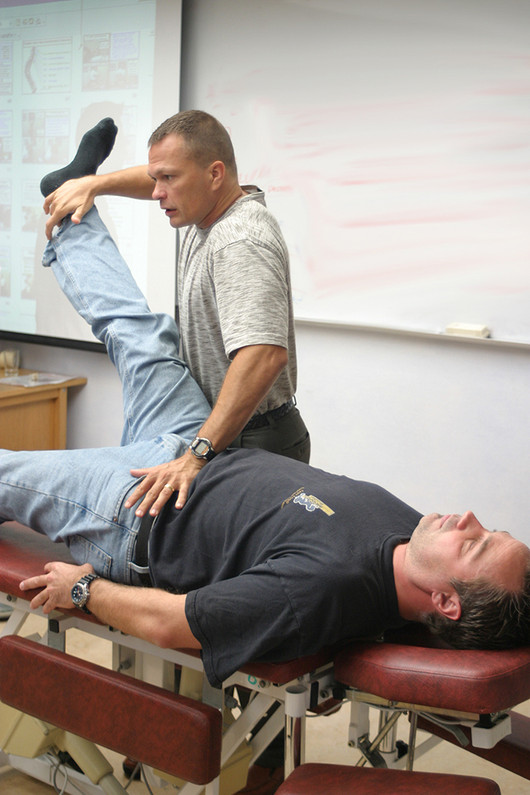Deciphering Strength: Understanding Manual Muscle Test Grading
Manual Muscle Testing (MMT) is a fundamental technique in physical therapy used to assess muscle strength and function in the rehabilitation and recovery process. It involves applying resistance to specific a specific muscle or muscle groups while the patient performs a designated movement. One crucial aspect of MMT is the manual muscle testing grading system used to quantify the strength of a muscle contraction. In this article, we will go over the various grading scales commonly employed in manual muscle testing and explore their clinical significance.
Importance of Manual Muscle Testing Grading
Manual Muscle Testing Grading grades the strength of muscle contractions that provides valuable information about the integrity of the neuromuscular system and helps guide treatment planning and monitoring progress. Accurate MMT grading allows clinicians to identify muscle weakness, asymmetries, or imbalances, which may indicate underlying pathology or functional limitations.
Common MMT Grading Scales
Several MMT grading scales are utilized in manual muscle testing, each with its unique characteristics. Among the most commonly employed MMT Grading scales are:
- The Medical Research Council (MRC) Scale, also known as the Oxford Scale is a widely accepted MMT grading system ranging from 0 to 5, with each grade representing a specific level of muscle strength (Source: Physiopedia: Muscle Strength Testing):
- Focus: Originally developed for assessing muscle weakness in conditions like neuropathies, such as Guillain-Barré Syndrome or muscular dystrophy.
- Application: Specifically assesses the strength of voluntary muscle contractions in patients with neurological impairments.
- Range: 0 to 5 MMT grading scale
- Grade 0: No contraction - no detectable muscle contraction (visible or palpation).
- Grade 1: Flicker or trace of contraction - detectable contraction (visible or palpation), but no movement achieved.
- Grade 2: Active movement with gravity eliminated - Limb movement achieved, but unable to move against gravity.
- Grade 3: Active movement against gravity - Limb movement against resistance of gravity.
- Grade 4: Active movement against gravity and some resistance - Limb movement against gravity and external resistance.
- Grade 5: Normal power (full resistance) or normal strength.
- Usage: Commonly used in neurology and neuromuscular assessment, focused on diagnosis and monitoring progressive muscle weakness rather than resistance strength in rehabilitation.
- The Daniels and Worthingham Scale is similar to the MRC scale but includes additional descriptors to differentiate between MMT grades more precisely.
- Focus: Used primarily in manual muscle testing (MMT), especially in the fields of physical therapy and occupational therapy.
- Application: Measures muscle strength based on the patient’s ability to move against gravity and resist external force.
- Range: 0 to 5 MMT grading scale
- Grade 0: No muscle contraction - complete lack of voluntary muscle contraction. The examiner is unable to feel or see any muscle contraction.
- Grade 1: Visible or palpable contraction without movement - Faint or "flicker" muscle contraction without any movement of the limb. The examiner can see or palpate some contraction activity of the muscle(s) or may be able to see or feel the tendon "pop up" or tense as the person tries to perform the contraction.
- Grade 2-: Gravity eliminated movement that is less than full range of motion.
- Grade 2: Full range of motion in a gravity-eliminated position - very weak muscle contraction with movement through complete range of motion in a position that eliminates or minimizes the force of gravity.
- Grade 2+: In gravity minimized portion, completes full available range and holds end position against mild resistance; or against gravity., completes up to half of the full range of motion.
- Grade 3-: Agains gravity, more that half but less than full range of motion.
- Grade 3 (Fair): Full range of motion against gravity, no resistance - Muscle can complete a full range of motion against only the resistance of gravity.
- Grade 3+: Completes full range of motion against gravity, and hods end position against mild resistance.
- Grade 4 (Good): Full range of motion against gravity, with moderate resistance - able to complete the full range of motion against gravity and can tolerate strong resistance without breaking the test passion. The grade 4 muscle clearly breaks with maximal resistance.
- Grade 5 (Normal): Full range of motion against gravity, with full resistance - Able to complete full range of motion and maintain end point range position against maximal resistance. The examiner cannot break the patients hold position.
- Usage: More detailed in assessing how much force the patient can resist, often used for clinical evaluation and rehabilitation.
- Other MMT Grading Scales
- Kendal Muscle Grading Scale: The MMT grades for this scale focus on positioning and stabilization during the manual muscle test that ensures accurate results by preventing compensatory movements. This attention to detail makes this muscle strength scale particularly effective for assessing specific muscle and muscle groups, rather than just overall limb or body strength.
- Lovett Scale: In the early 20th century Robert W. Lovett developed The Lovett Scale which was the very first muscle strength scale to be developed to attempt to qualify muscle strength. The Lovett scale grades muscle strength as a percentage of normal, ranging from 0% to 100%. The manual muscle testing grades for this scale was mainly used to assess polio, spinal cord injuries, or muscle atrophy. The Daniels and Worthington Scale (introduced in the 1940s) expanded on the Lovett Scale by incorporating detailed guidelines for manual muscle testing and position.
Application of Manual Muscle Testing Grading
In manual muscle testing (MMT), the clinician applies resistance to the patient’s movements, evaluating their ability to maintain the position against this resistance. The MMT grading is determined by the amount of resistance the patient can overcome while performing the movement, providing a standardized method to assess muscle strength.
Interpretation and Clinical Considerations
Accurate interpretation of manual muscle testing results requires careful consideration of several factors, including the patient's age, gender, activity level, and medical history. Clinicians must also observe for any signs of compensatory movements, pain, or fatigue during testing, as these factors can affect the accuracy of the muscle strength grading.
It is crucial to compare muscle strength on both sides of the body and across different muscle groups to detect any asymmetries or imbalances. A thorough understanding of the grading scale and its clinical implications allows for precise interpretation and effective treatment planning.
Manual muscle testing grading is a vital tool in physical therapy assessments, offering insights into muscle functionand strength. By using standardized grading scales and considering each patient's unique circumstances, clinicians can effectively assess muscle strength, track progress, and customize treatment interventions to optimize outcomes. Additionally, clear communication with patients and collaboration with other healthcare professionals enhance the effectiveness of MMT in rehabilitation.
Recent Posts
-
Acupuncture vs. Dry Needling: What’s the Difference?
At first glance, acupuncture and dry needling might seem identical. Both involve inserting thin need …Jun 11th 2025 -
What Is Dry Needling? A Modern Approach to Pain Relief and Muscle Recovery
Chronic muscle pain, tension, and restricted movement can significantly impact your daily life, sign …Jun 11th 2025 -
The Kinetic Chain and Its Importance?
The kinetic chain is a key principle in physical therapy, referring to the way muscles, joints, and …Apr 18th 2025



